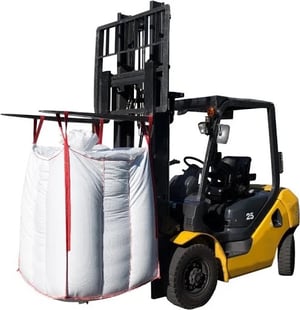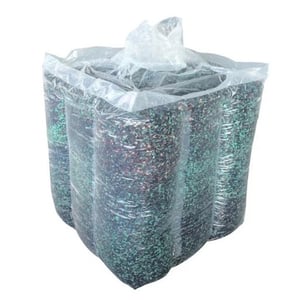How to Choose the Right Bulk Bag Sizes for Your Needs
March 25, 2024
A flexible intermediate bulk container (FIBC) is a woven polypropylene bag designed to store and transport heavy industrial materials. Some types of FIBCs feature baffles, which are fabric panels or strings sewn inside each of the bag’s four corners to allow it to maintain a square shape when filled.
In this blog, learn all about the various types of baffle FIBC bags, their benefits, applications, and more.

A baffle bag is a type of FIBC equipped with internal components — called baffles — that help the bulk bag maintain a square shape during filling, transport, and storage. Baffle, formstable, and Q-bag are all terms for the same type of square FIBC.
Baffle bags are ideal due to their stability and stackability. They also improve overall storage capacity. Without baffles, a standard bulk bag can bulge or belly at the sides when filled.
Choose Your FIBC
There are three basic types of baffle FIBC bag constructions: 4-panel, U-panel, and circular or tubular.
The most common type of baffle FIBC, 4-panel bags are constructed with five main body components: four side panels and a base.
When filled, a 4-panel bag will hold its square shape similar to other construction types. That said, 4-panel bags will hold their shape better than U-panel bags, and U-panel bags will hold their shape better than a circular bag.
Due to the large amount of stitching required, a 4-panel bag has a greater opportunity to fail at the seams and is prone to sifting. Nevertheless, 4-panel bags are ideal for storage due to the way they hold their shape when filled.
U-panel baffle bags are constructed with three main body components: one that runs the full length of the bag forming the bottom and two sides (the “U”) and two additional pieces of fabric sewn between the U on two sides (the “panel”).
Generally, U-panel bags will maintain a square shape when filled, especially with the addition of internal baffles. Standard U-panel bags are extremely common. However, U-panel baffle bags are less common than 4-panel baffle and tubular baffle bags.
.jpg?width=300&height=225&name=Image%203-25-24%20at%203.58%20PM%20(1).jpg)
A unique type of baffle FIBC, circular baffle bags are constructed with two main body components: the body tube and the base.
The body tube is made with seamless tubular fabric that forms all sides of the bag, allowing for stitching only for the top and base of the bag. Although the fabric is tubular, when filled, the circular baffle bag will still resemble a square bag. With the addition of internal baffles, the bag will form a square profile with rounded corners.
There is a common misconception about circular bags regarding their shape when filled. They are not truly circular; they are simply constructed with a single piece of fabric that forms all four sides of the bag.
While they still resemble square/rectangular FIBCs, they will hold that shape the least of the construction types when filled.
.jpg?width=350&height=327&name=Image%203-25-24%20at%203.58%20PM%20(2).jpg)
Baffle bags offer numerous functional benefits versus standard U-panel and tubular bulk bags, including:
Baffled bags are ideal for dry free-flowing products, such as:
Large bulky materials with limited flowability are not recommended for use in a baffle bag due to their tendency to get hung up in the internal baffles. These types of products will not fill out the corners of the bag which can lead to instability.
Whether you must choose a baffle bag or opt for a regular FIBC bulk bag will depend entirely on your material and application.
Typically, FIBC Q-bags work best for finer powders and find maximum use in the food, agricultural, and chemical industries. However, anyone in need of packing more material within limited space or looking to save costs in storage and transportation can take advantage of the structural and space-saving features of these bags.
Their robust, reinforced structure makes them a great fit for applications where you need:
REQUEST A QUOTE
Bulk bag cost is a function of several components including bag size, bag style, fabric weight, and fabric type. A baffle bulk bag will typically cost 15% to 25% more than a standard U-panel or circular/tubular bulk bag. This is due to the additional raw materials and labor included in the bag.
Yes. A baffle FIBC can be produced in a food grade facility and assembled using food safe manufacturing practices. These include:

Oftentimes, a standard baffle FIBC is insufficient for ultra-clean applications. When the functionality of a baffled bag and film liner is required, a baffled liner is appropriate.
Baffled liners allow a standard bulk bag to maintain a square shape. The liner is form fitted to the bag and utilizes internal baffles to prevent bulging that could result in a rounded footprint. The square shape promotes greater bag stability and stackability and improves storage capacity.
Other features and benefits of baffled liners include:
Southern Packaging, LP stocks over 1,000,000 bulk bags available in hundreds of sizes and styles. Our baffle, U-panel, and circular-style bulk bags are suitable for nearly any industrial application.
Our highly stable and superior-grade baffle bags are available in almost any size. We can also build a custom size for your specific needs. Contact our experienced sales team for more information.